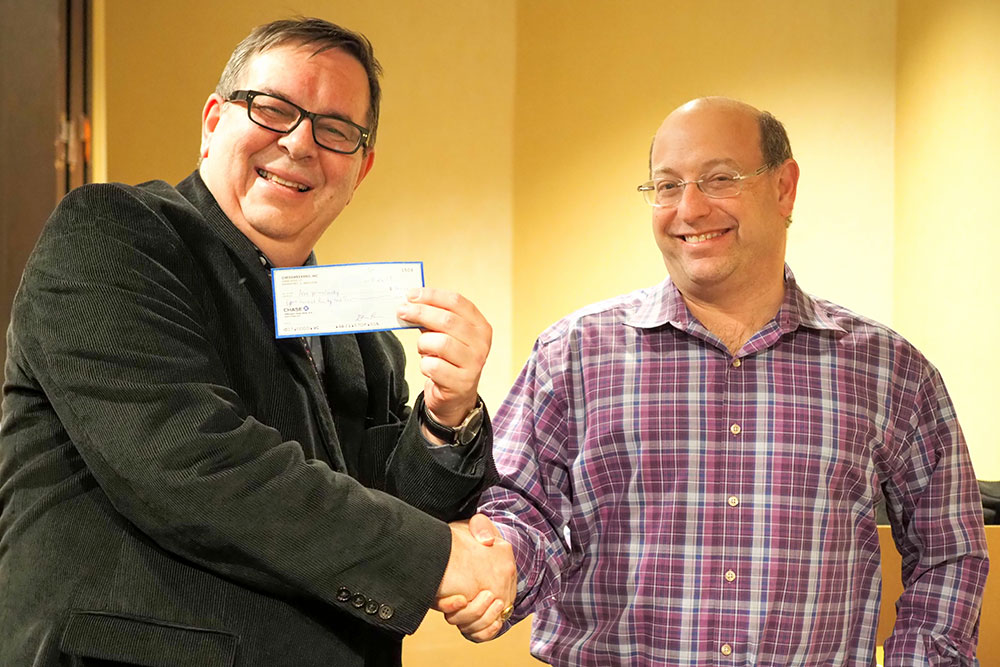Honouring a departed friend
First, a word from the organizers:
“The 2nd Sevan Muradian memorial organized by Glenn Panner and Daniel Parmet is a charity tournament that donates its profits to our dearly departed friend's family. Sevan Muradian was an organizer, director, mentor and friend to the IL community. He ran over 200 tournaments of which 32 were norm tournaments that produced 30 norms for 20 different people. The biggest news in the weeks leading up to the tournament was that Super GM Hikaru Nakamura was donating matching profits up to $3,000 to the beneficiary of the tournament, the Muradian family, to encourage participation by the community. The tournament ended up with 134 players from six states including 2 GMs, one IM, two FMs and seven other masters. The tournament was won by GM Alex Yermolinsky with a perfect score. FM David Peng took second place with 4½ / 5. The tournament was staffed with volunteers Sam Shoykhet, John Porter, Ken Ballou, Daniel Parmet and Glenn Panner. Sevan's passion for chess - especially master chess and opportunities for upcoming players is missed but not forgotten.”
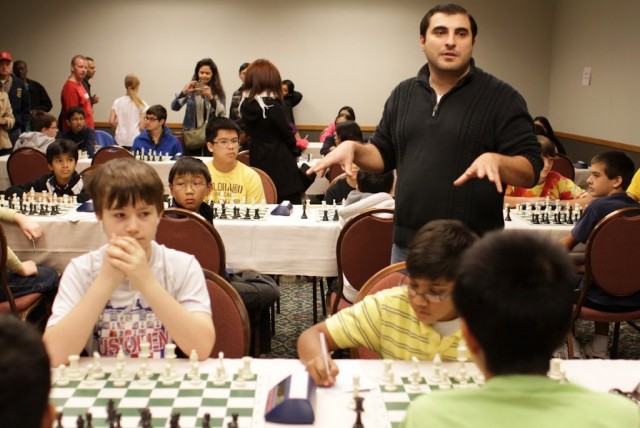
Sevan Muradian the Susan Polgar Foundation World Open for Boys and Girls in Chicago | Photo: Paul Truong
The Hyatt in a Chicago suburb of Schaumburg, Illinois has hosted many chess events. I played there some time in the late 1990s and remember what a big issue it was to fight my way through traffic! Schaumburg is located on the western fringes of the Greater Chicago area, and those of us who were coming from the East took the brunt of it all.
Now, as I came from the West, it was a piece of cake! The Hyatt has a great restaurant, and there's a mall nearby, so the players and their companions had a comfortable stay.
A critical point in my tournament came early. In round one I faced an unknown (to me) player of high school age, Eric Starkman, who played a solid game in the Nimzo-Indian Defense.

[Event "Muradian Memorial"] [Site "?"] [Date "2017.11.24"] [Round "1"] [White "Yermolinsky, Alex"] [Black "Starkman, Eric Cha"] [Result "1-0"] [ECO "E47"] [WhiteElo "2490"] [BlackElo "1754"] [Annotator "AlexYermo"] [SetUp "1"] [FEN "1r3rk1/3b1pp1/pp1b3p/3Pq3/8/P1Q1B2P/BP4P1/2R2RK1 w - - 0 26"] [PlyCount "49"] [EventDate "2017.??.??"] {[#] My only hope to win this game was his clock situation.} 26. Qxe5 ({ I didn't rate my chances high in the endgame after} 26. Bf4 Qxc3 27. Rxc3 Bxf4 28. Rxf4 Rbc8 29. d6 (29. Rxc8 Rxc8 30. d6 Be6 $11) 29... Rxc3 30. bxc3 b5 { and, besides, he would have been playng his moves quickly.}) 26... Bxe5 { Therefore, I gambled,} 27. d6 $5 {and it paid off!} Bxb2 $2 (27... Bb5 28. Rf5 (28. Rfd1 Bxb2) 28... Bxd6 29. b4 Rb7 {White can only hope for a draw here.}) 28. Rc7 Be6 {Just seconds left on his clock, and my opponent entered a losing line.} (28... Rbd8 29. Bxb6 Bf6 $16) 29. Bxe6 fxe6 30. Rxf8+ Kxf8 31. d7 $18 Rd8 32. Bxb6 Ke7 33. Bc5+ $1 {It is important to save the a-pawn.} Kf7 34. Rb7 $1 {Pushing the bishop away is the key idea.} Bf6 35. Bb6 e5 36. Kf1 Ke6 37. Bxd8 Bxd8 38. Ke2 Kd6 39. Kd3 Kc6 40. Ra7 a5 41. a4 Kb6 42. Ra8 Kc7 43. Rxa5 Kd6 44. Ra8 Kxd7 45. Ke4 Bf6 46. Kd5 Kc7 47. Ra6 Kb7 48. Re6 Kc7 49. Rxe5 Bxe5 50. Kxe5 1-0
In general, I prefer to have sharp, tactical games in early rounds. It is important not just to win, but win quickly, to conserve the much needed energy. You know, the tank no longer has full capacity. There are a lot of good young players around, and going through long, drawn out battles is too taxing for an older player. It makes sense to throw your chips down and see if it goes your way.

[Event "Muradian Memorial"] [Site "?"] [Date "2017.11.25"] [Round "2"] [White "Zhang, Richard"] [Black "Yermolinsky, Alex"] [Result "0-1"] [ECO "B81"] [WhiteElo "1707"] [BlackElo "2490"] [Annotator "AlexYermo"] [PlyCount "56"] [EventDate "2017.??.??"] 1. e4 c5 2. Nf3 d6 3. d4 cxd4 4. Nxd4 Nf6 5. Nc3 e6 {I can't say I'm esctatic to play the old Scheveningen again, but it helps me to get my young opponents off theoretical tracks.} 6. g4 (6. Be2) 6... h6 7. h4 Be7 $5 {My old line that I almost swore to abandon after a 22 move loss to Panchanathan in the Copper State Open, 2010} ({There's also an old Andersson-Ehlvest line} 7... Nc6 8. Rg1 h5 9. gxh5 Nxh5 {I might one day resort to.}) 8. Rg1 d5 {As expected the kid started burning time here.} 9. Bb5+ ({I more or less know what awaits Black in } 9. exd5 Nxd5 10. Nxd5 Qxd5 11. Be3 Bd7 (11... Nc6 $142) 12. Bg2 Qc4 13. Qe2 Qxe2+ 14. Kxe2 Nc6 15. Nxc6 Bxc6 16. Bxc6+ bxc6 17. h5 $16) 9... Kf8 10. e5 { Loads and loads of time.} Nfd7 {[#]} 11. Nxe6+ $4 {This came after another long think. Obviously White's nowhere near ready to sacrifice pieces.} ({ Magesh's} 11. Qe2 Bxh4 12. Bd2 $5 {remains a critical test for the entire line. } Nc6 13. Nf3 Be7 14. O-O-O Qc7 ({instead of my crazy} 14... g5) 15. g5 $1 hxg5 16. Nxg5 Qxe5 (16... Ndxe5 17. f4) 17. Qg4 Ke8 (17... Nf6 $2 18. Nxe6+) (17... Bf6 18. Bf4 Bxg5 19. Bxg5 g6 20. Rde1 Qh2 {looks very shaky for Black}) 18. f4 Qf6 19. f5 d4 20. fxe6 (20. Bxc6 dxc3 21. Bxd7+ Bxd7 22. Bxc3 Qxf5 23. Qxf5 exf5 $11) 20... dxc3 21. exf7+ Kf8 22. Ne6+ Kxf7 23. Bxc3 Nde5 {Can Black play like this and survive to tell the tale?}) 11... fxe6 12. g5 hxg5 ({I saw no reason to resort to} 12... h5) 13. Qf3+ (13. Bxg5 Nxe5 14. Qe2 Bxg5 15. hxg5 a6 $19) 13... Kg8 14. Nxd5 {Obviously, he counted on this one, but being an hour ahead on the clock I had time to find a refutation.} Nxe5 15. Nxe7+ Qxe7 16. Qc3 {[#] Here my wife Camilla, who was not playing in the tournament, came to check on the games. She spotted me deep in thought, clutching my head between my hands. She instantly realized I had seen everything and was confident in victory.} Nbc6 17. Bxg5 Qb4 $1 {It's all about this move.} 18. Qxb4 (18. Be2 Qxc3+ 19. bxc3 Kf8 $19) 18... Nf3+ 19. Kf1 Nxb4 20. Rg3 Nxg5 21. Rxg5 Rxh4 22. Kg2 a6 23. Kg3 Rh6 24. Ba4 Nd5 25. c4 Nf6 26. Bc2 Bd7 27. Rg1 Rf8 28. f4 Bc6 { This game explains why I need to stick to my Sicilians for the rest of my career/life. This way I can win, win quickly, and even more importantly, tactical play helps me get my juices flowing for the rest of the tournament.} 0-1
The name Sicilian Defence (1.e4 c5) describes a number of systems, each of which could easily be considered as an independent opening. The problems in the Paulsen, Richter Rauzer or Sveshnikov are complex, but the Sicilian pawn structures tie them all together. The Scheveningen Sicilian is central to an understanding of them.
Clearly, my opponent overreacted to Black's outrageous setup. I have noticed that most young players I meet during my travels, while being quite skillful in positional play, particularly in familiar setups, are still lacking a bit in the tactical department. I wonder if studying with computers has this unexpected impact. It is pretty hard to develop as an attacking player when all your ideas instantly get brushed aside by the merciless machine mind.
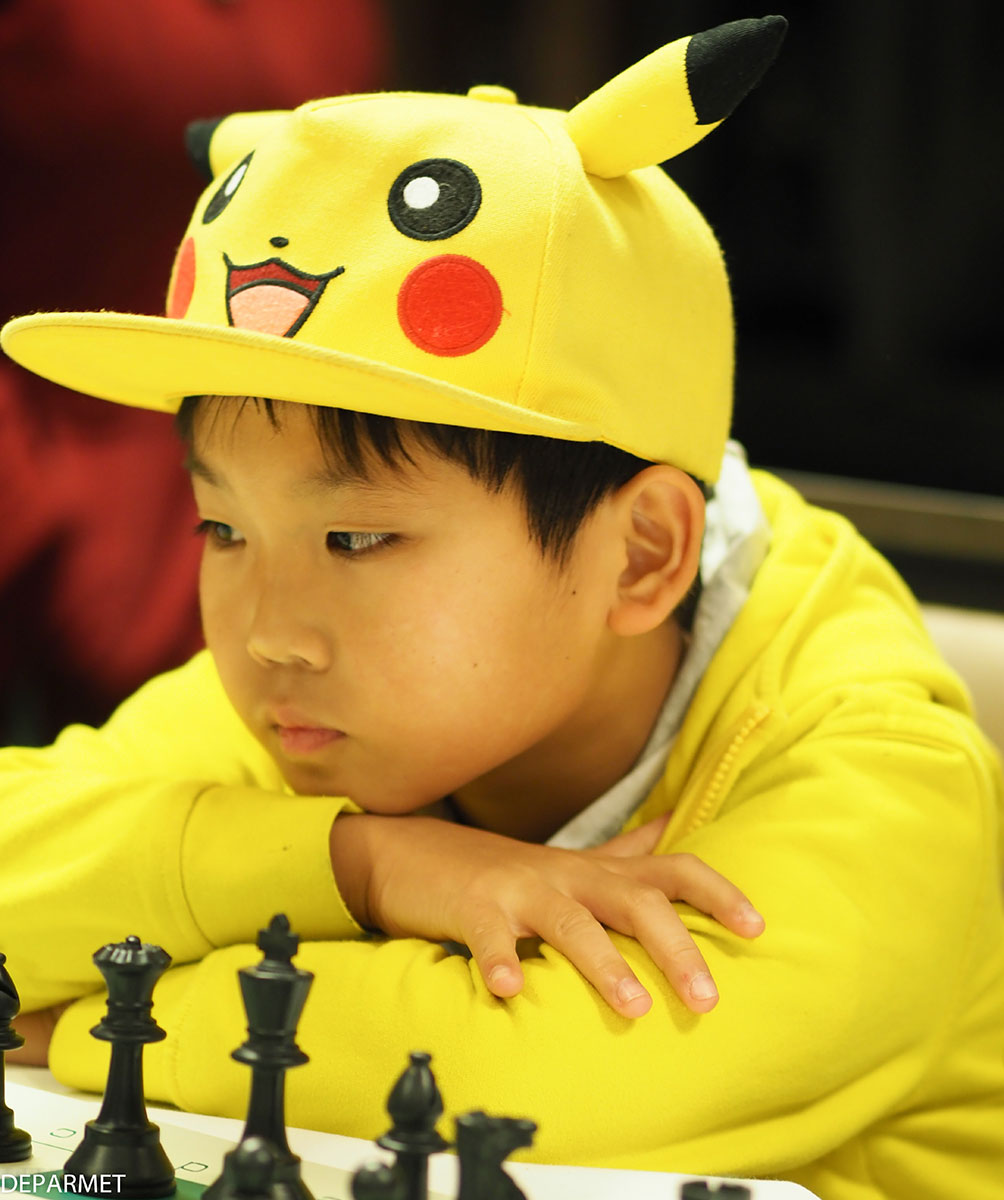
Does your favorite Pokemon help your chess? Pikachu sure does! | Photo: Daniel Parmet
I got real lucky in round three. Shreya Mangalam is 14, and she's a real talent, but her opening treatment in our game was too risky. The mix of Slav with the Grunfeld left her dark-squares weak, and the absence of the queen, who went pawn hunting rather than stay in defense, proved to be fatal.

[Event "Muradian Memorial"] [Site "?"] [Date "2017.11.25"] [Round "3"] [White "Yermolinsky, Alex"] [Black "Mangalam, Shreya"] [Result "1-0"] [ECO "A13"] [WhiteElo "2490"] [BlackElo "1884"] [Annotator "AlexYermo"] [SetUp "1"] [FEN "r1b2rk1/pp1nn2p/2p1ppp1/3p2PP/2qP1Q2/2N2N2/PP2PPB1/2KR3R b - - 0 16"] [PlyCount "20"] [EventDate "2017.??.??"] {[#]} 16... f5 $2 {A losing move.} ({It would still be tough to defend after} 16... fxg5 17. Qxg5 Qb4 18. e4 dxe4 19. Nxe4 Rf5 20. Qh6 Rb5 21. Rd2 Nf5 22. Qf4 $16 {as Bc8 and Ra8 remain on the sidelines.}) 17. Qd6 Rf7 {here I was able to spot a pretty idea.} 18. Ne5 $1 $18 Nxe5 19. Qd8+ $1 Rf8 20. Qxe7 Rf7 21. Qd6 (21. Qd8+ Rf8 22. Qd6 Nf7 23. Qe7 {also does it.}) 21... Nd7 22. hxg6 hxg6 23. Rh4 ({Alternately, White can also win with} 23. Qxe6 Nf8 24. Rh8+ Kxh8 (24... Kg7 25. Qe5+ Rf6 26. Qxf6#) 25. Qxf7) 23... Nf8 24. Rdh1 Rg7 25. Rh8+ Kf7 26. Qxf8# 1-0
How it was possible to get to 3 out of 3 without facing a single 2000+ player is beyond me. Possibly the tournament could do with a separate Under 2000 section, but I understand the rationale of giving young players a chance to meet a grandmaster at the board.

One of the legends of US chess: Dmitry Gurevich | Photo: Daniel Parmet
The other GM in the tournament was my old friend, Dmitry Gurevich. We anticipated meeting face-to-face at some point, but Dmitry made one draw too many and fell behind in the race. In round four he made another quick draw with his former student, FM David Peng, while I had black against Jonathan Kogen.
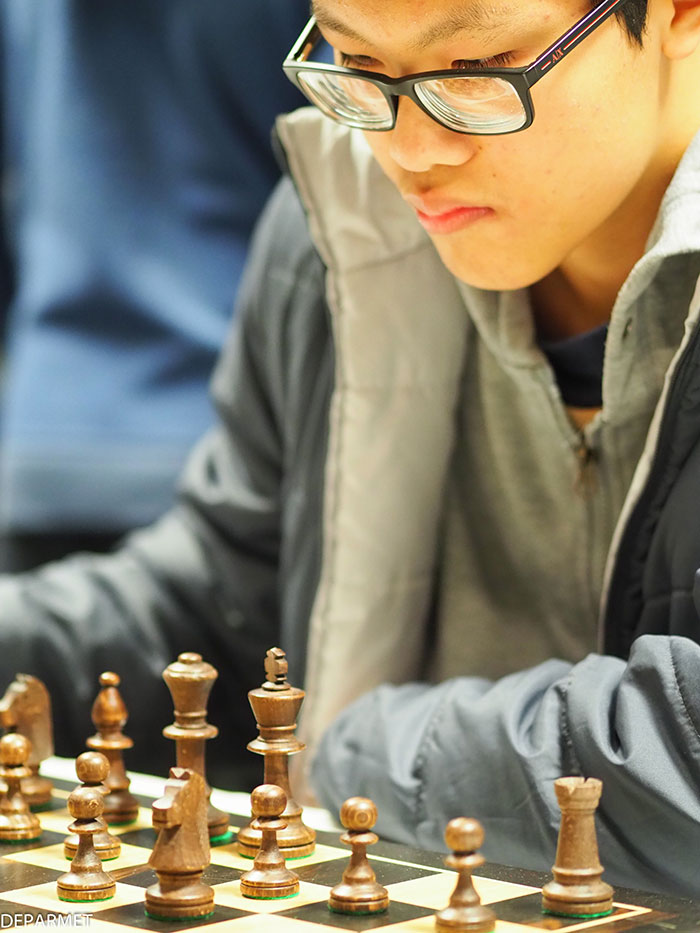
FM David Peng | Photo: Daniel Parmet

[Event "Muradian Memorial"] [Site "?"] [Date "2017.11.26"] [Round "4"] [White "Kogen, Jonathan"] [Black "Yermolinsky, Alex"] [Result "0-1"] [ECO "E32"] [WhiteElo "2212"] [BlackElo "2490"] [Annotator "AlexYermo"] [PlyCount "96"] [EventDate "2017.??.??"] 1. d4 Nf6 2. c4 e6 3. Nc3 Bb4 4. Qc2 O-O 5. a3 Bxc3+ 6. Qxc3 b6 7. Bg5 Bb7 8. f3 h6 9. Bh4 d5 {A solid theoretical line. I didn't care much for "mixing it up" early. Experience has taught me that a draw with Black cannot always be avoided.} 10. e3 {Most popular.} (10. cxd5 exd5 11. e3 (11. Bxf6 Qxf6 12. Qxc7 Ba6 13. Qe5 Qc6 $44 {can be dangerous for White.}) 11... Re8 12. Bf2 c5 13. Bb5 cxd4 14. Qxd4 Bc6 15. Bd3 Nbd7 16. Ne2 Nc5 17. Bc2 Bb5 18. Qd2 Rc8 19. Nd4 Bc4 {was an old game Seirawan-Karpov, 1989}) 10... Nbd7 11. cxd5 Nxd5 (11... exd5 12. Bd3 Re8 13. Ne2 Qe7 14. Bf2 c5 15. O-O $14) 12. Bxd8 Nxc3 13. Bh4 Nd5 14. Bf2 c5 ({Another option is} 14... f5 15. Bb5 c6 16. Bd3 e5 17. Ne2 Rae8 18. O-O exd4 19. Nxd4 Nxe3 20. Bxe3 Rxe3 21. Bxf5 Nf6 22. Rfe1 $14) 15. e4 Ne7 16. Ne2 f5 {Without this undermining shot Black is doomed to a long defense in a slightly worse position.} 17. exf5 Nxf5 {All this has been played before.} 18. O-O-O (18. dxc5 Nxc5 19. Nc3 Rfd8 20. Rd1 {is what White normally plays.}) 18... Rad8 {[#] I left my other rook on f8 to specifically prevent White's idea of attacking the 6-pawn} 19. Nf4 $5 {However, after some think my opponent did just that!} Nxd4 20. Bxd4 Rxf4 21. Be5 Rf7 22. Bc4 Re8 23. Bc3 { The idea of his pawn sacrifice was to underline the power of the bishops.} Bd5 $1 ({I saw no future in} 23... Nf6 24. Rhe1 Rfe7 {Black is just too passive.}) 24. Rxd5 exd5 25. Bxd5 Kf8 ({I calculated a pawn ending after} 25... Nf6 26. Bxf6 gxf6 27. Rd1 Kg7 28. Bxf7 Kxf7 29. Rd7+ Re7 30. Rxe7+ Kxe7 31. g4 Ke6 32. Kd2 Ke5 33. Ke3 {The only move that saves Black is} f5 $1 $11) 26. Bxf7 Kxf7 27. Rd1 Nf6 28. Kc2 ({More practical was to keep the rooks on the board.} 28. Rd2 {In that case I would have to take some steps against the plan of the white king's invasion of my Q-side.} b5 29. Kc2 a6 {and Black should hold with no particular difficulty.}) 28... Re2+ 29. Rd2 Rxd2+ 30. Kxd2 Nd5 31. Be5 c4 $1 {Building the barrier on the path of the king.} 32. f4 g5 $1 {Black must play actively.} (32... g6 33. Ke2 Ke6 34. Kf3 h5 35. Ke4 b5 36. Kd4 $16) 33. fxg5 ( 33. f5 {would have lead to a forced draw:} g4 34. h3 h5 35. hxg4 hxg4 36. Bd4 a6 37. Ke2 b5 38. Kf2 a5 39. Kg3 b4 40. axb4 axb4 41. Kxg4 b3 42. Kf3 c3 43. Bxc3 Nxc3 44. Ke3 Na4 45. Kd3 $11) 33... hxg5 34. g4 Ke6 35. Bd4 a6 36. a4 b5 37. axb5 axb5 38. Kc2 b4 {[#] OPf course, Black is perfectly safe, but winning the game was out of the question until Jonathan's horrible blunder.} 39. Bg7 $4 (39. b3 c3 40. Kd3 Nf4+ 41. Kc2 Kd5 42. Bf6 Ne2 43. Kd3 $11) 39... Ne3+ 40. Kd2 Nxg4 41. Bf8 b3 $19 42. Kc3 Kd5 43. Be7 Nf2 44. h4 g4 {Just a bit of calculation was required.} ({I didn't want to prolong the game with} 44... gxh4 45. Bxh4 Nd1+ 46. Kd2 Nxb2 {although Black is winning, e.g.} 47. Bf6 Na4 48. Bg7 Kc5 49. Bf8+ Kb5 50. Bg7 Kb4 51. Bf8+ Nc5) 45. Bd8 g3 46. Bb6 Ne4+ 47. Kb4 c3 $1 48. Kxb3 Nc5+ {Now Black will queen his pawn.} 0-1
So, once again, luck was on my side. Clearly, I had no business winning this endgame.
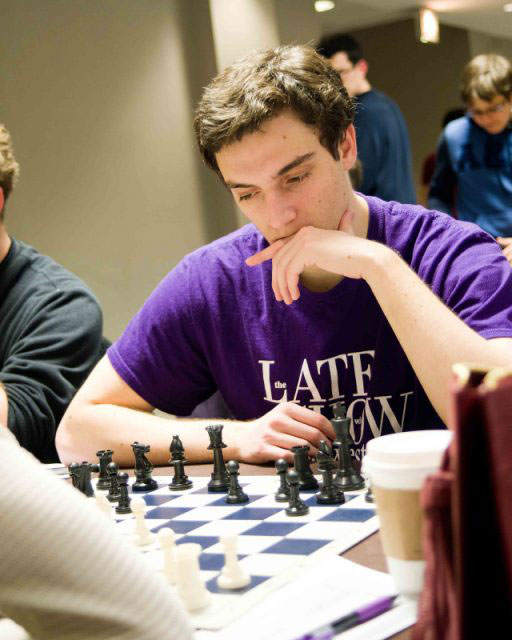
Jonathan Kogen | Photo Betsy Dynako
The stage seemed set for a Yermolinsky-Peng, but the computer thought different and, instead paired me with another FIDE Master, Igor Tsyganov. At least I got to play somebody a little too old to be my grandson.
Some 10-15 years ago Igor was a fixture in the Chicago chess scene, but he has played very sporadically in the past nine years. Same story, I guess: married with kids, a job and a mortgage. Life has an annoying habit of getting in the way of chess. Now, as his kids grew up and learned to play chess, Dad has to take them to tournaments. That way he can make a comeback of his own. Getting to 3½ / 4 was an encouraging sign, but in the final game Tsyganov's rustiness was telling in his unsure handling of the opening and poor time management.

[Event "Muradian Memorial"] [Site "?"] [Date "2017.11.26"] [Round "5"] [White "Yermolinsky, Alex"] [Black "Tsyganov, Igor"] [Result "1-0"] [ECO "A30"] [WhiteElo "2490"] [BlackElo "2264"] [Annotator "AlexYermo"] [PlyCount "55"] [EventDate "2017.??.??"] {My opponent was playing his first tournament in ten years.} 1. Nf3 Nf6 2. c4 e6 3. Nc3 c5 4. g3 b6 5. Bg2 Bb7 6. O-O Be7 7. d4 cxd4 8. Qxd4 Nc6 {This old version of the Hedgehog has never been refuted, although most players prefer the flexible position of the knight on d7.} 9. Qf4 O-O 10. Rd1 a6 {Perhaps, slightly inaccurate.} (10... Qb8 {is the main move:} 11. e4 d6 12. b3 Rd8 13. Bb2 a6 14. Qe3 Qa7 15. h3 Rab8 $14 {Carlsen-Wang Yue, 2009}) 11. b3 ({In case of} 11. e4 {Black holds his own after} d6 12. b3 Qc7 13. Ba3 Rad8 14. Rac1 Ne5 {sidestepping the Nd5 threat and keeping the d6-pawn safe.}) 11... Rc8 ({ During the game I was wondering about} 11... b5 12. cxb5 axb5 13. Nxb5 Nd5 14. Qd2 Ba6 {and thought I'd have to continue with} 15. e4) 12. Bb2 $6 ({I didn't realize that} 12. e4 $1 d6 13. Ba3 $1 {would be perfectly timed now.} b5 $5 14. Bxd6 Bxd6 15. Rxd6 Qa5 16. Rc1 bxc4 17. e5 $1 $16) 12... Qc7 {This can safely be played now, as the white bishop has been diverted from the h2-b8 diagonal.} 13. Ng5 $5 {In search of new ideas I decided to offer a slight pawn structure change.} (13. Qxc7 Rxc7 14. Nd5 exd5 15. cxd5 Nxd5 16. Rxd5 $14) 13... Qxf4 14. gxf4 Rfd8 15. Rac1 d6 16. Bh3 $5 {[#]} h6 $2 {It seems that my opponent just didn't believe I was serious about taking on e6.} ({Otherwise he could have tried} 16... Rb8 {In that case I would have tried} 17. f5 {White must be prepared to face} Nh5 $1 (17... h6 18. Nf3 e5 19. Bg2 Bc8 20. e4 $14) 18. Nge4 Nf4 19. Bf1 exf5 20. Ng3 g6 21. e3 Ne6 22. Nd5 {with sharp play.}) 17. Nxe6 fxe6 18. Bxe6+ Kf8 19. Bxc8 Bxc8 (19... Rxc8 20. Nd5 Nxd5 21. cxd5 Na7 22. Rxc8+ Nxc8 23. f5 $16 {There are many examples of rook versus two minor pieces endgame play. I'd particularly mention Kramnik's games.}) 20. Nd5 Nd7 21. Ba3 $1 {Forcing the win on a third pawn.} Nf6 (21... Nc5 22. Nxb6 Bh3 23. Nd5 Bh4 24. Rc3 Bc8 25. f3 $18) 22. Nxb6 $18 d5 $2 {Time trouble collapse.} ({Black had to keep pieces on the board, so} 22... Be6 23. Nd5 a5 {was the way to continue.}) 23. Bxe7+ Nxe7 24. Nxc8 Rxc8 25. cxd5 Rxc1 26. Rxc1 Nfxd5 27. Rc4 a5 28. Rc5 (28. Rc5 Nxf4 29. e3) 1-0
On this DVD, Shirov focuses on his most outstanding achievements in the Sicilian, a personal selection combining highest chess quality with aesthetic pleasure. His lectures are designed to not only explain the different opening lines, but also to present interesting and sometimes perplexing ideas and sacrifices in the middlegame.
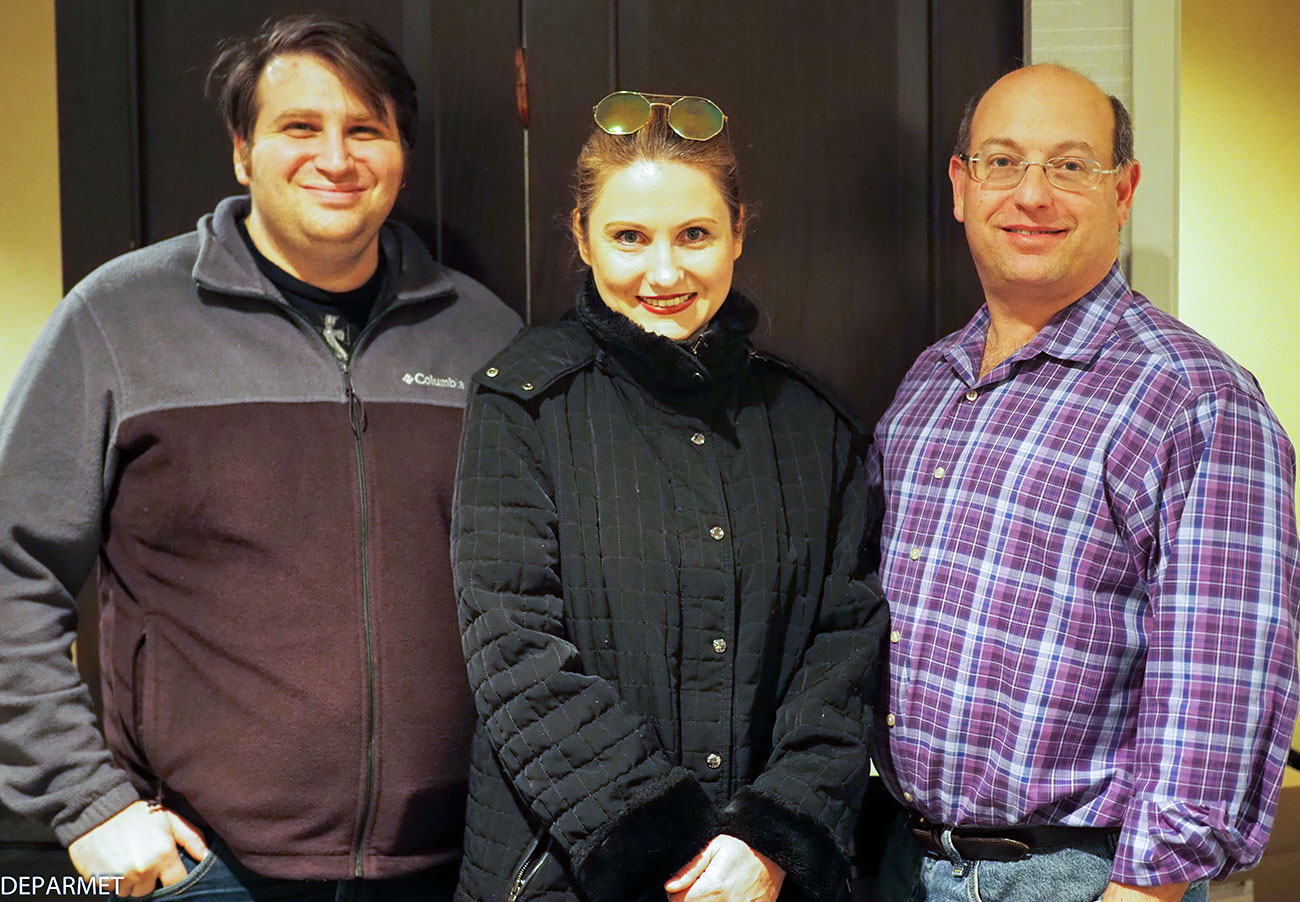
Daniel Parmet, Yana Muradian (sevan's widow), and Glenn Panner | Photo: Daniel Parmet
Correction, December 21: Hikaru Nakamura did not donate to the prize fund, as originally stated. Instead, the profits from the event went to Sevan Muradian’s widow and children and Nakamura offered to match up to $3K raised
